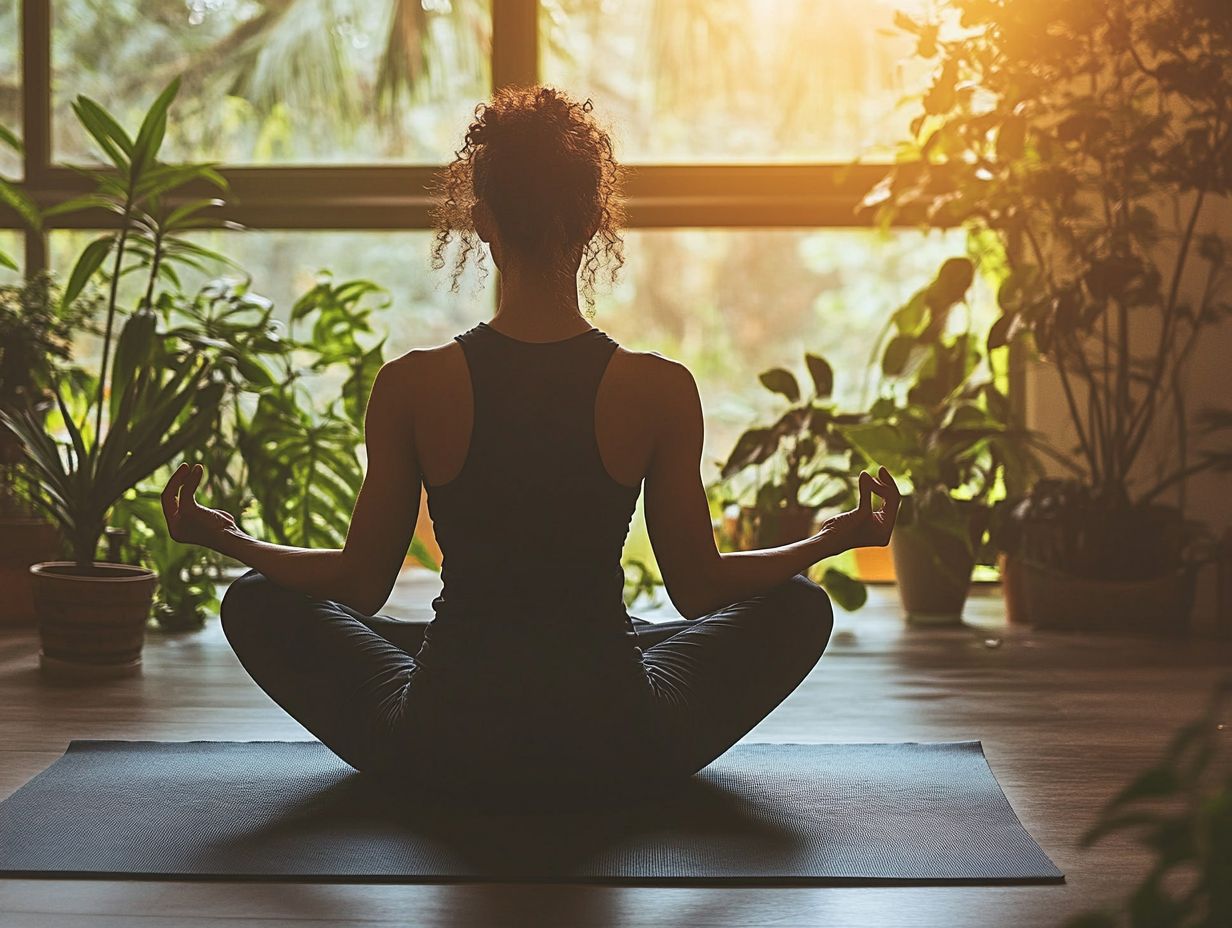Breathwork: A Game-Changer for Relaxation
Breathwork is not just a trend. It’s a powerful practice that taps into the transformative potential of your breath to elevate your physical and mental well-being. This article explores breathwork’s essence and scientific basis, highlighting its influence on your body and mind. You’ll discover numerous benefits, explore various techniques, and find practical tips to easily integrate it into your daily routine. Whether you’re just starting or looking to deepen your practice, this guide is for everyone. Get ready to unlock a new realm of relaxation and mindfulness!
Contents
- Key Takeaways:
- What is Breathwork?
- The Science Behind Breathwork
- Benefits of Breathwork
- Different Types of Breathwork
- How to Incorporate Breathwork into Your Routine
- Combining Breathwork with Other Relaxation Techniques
- Frequently Asked Questions
- What is breathwork, and how can it help you relax?
- How does breathwork differ from traditional relaxation techniques?
- What are the benefits of incorporating breathwork into my relaxation routine?
- Can anyone practice breathwork, or is it only for experienced meditators?
- Is breathwork safe for everyone to do?
- How often should I practice breathwork for relaxation?
Key Takeaways:

- Breathwork is an intentional practice of controlled breathing, focusing on techniques such as mindfulness meditation to promote relaxation and improve overall well-being.
- Backed by science, breathwork has a positive impact on both the body and mind, reducing stress and increasing focus.
- Incorporating breathwork into your routine provides numerous physical and mental benefits, making it a game-changer for relaxation.
What is Breathwork?
Breathwork is a comprehensive method that offers a variety of techniques to optimize your breath, enhancing your physical and mental well-being. Engaging in methods like mindfulness meditation and deep breathing helps activate the part of your nervous system that aids relaxation, leading to significant improvements in stress management and emotional regulation, enhancing your emotional awareness.
This practice encourages you to explore your relationship with breath, which is essential for fostering emotional awareness, mastering relaxation techniques, and achieving overall wellness, while also enhancing your body awareness and lung capacity.
Explanation of the Practice
Breathwork encompasses a variety of techniques designed to facilitate relaxation and enhance emotional awareness through mindful breathing practices. Among these techniques, deep breathing serves as a foundational approach, inviting you to take slow, measured breaths that can significantly lower your stress levels. Simultaneously, diaphragmatic breathing promotes optimal oxygen flow and enhances physical well-being. Other methods, like box breathing, help you ground yourself by synchronizing inhalation and exhalation with specific time intervals, fostering a meditative state.
These varied approaches not only aid in managing anxiety but also lead to a deeper sense of inner peace, paving the way for improved emotional clarity and self-reflection.
The Science Behind Breathwork
The science behind breathwork reveals its remarkable effects on your body and mind, illustrating how controlled breathing can influence heart rate variability and enhance oxygen utilization, ultimately improving your mental health.
Exploring techniques like cyclic sighing and resonance breathing may lead to enhanced performance and significant relief from anxiety, while offering both physiological and psychological rewards supported by studies published in JAMA Internal Medicine and Applied Psychophysiology and Biofeedback.
How it Affects the Body and Mind
Breathwork profoundly impacts your body and mind, acting as a remarkable tool for managing stress and regulating emotions. This ancient practice includes various techniques crafted to enhance your body s natural rhythms, promoting a harmonious balance between physical vitality and mental clarity.
By concentrating on your breath, you activate your parasympathetic nervous system, which decreases your heart rate and lowers blood pressure. Breathwork encourages mindfulness, helping you become more attuned to your thoughts and feelings, fostering emotional resilience.
Integrating breath-focused exercises into your daily routine not only helps you navigate stressful situations but also enhances your overall wellness. This practice lays a solid foundation for a healthier, more balanced life.
Start your breathwork journey today for immediate benefits!
Benefits of Breathwork

The advantages of breathwork extend into the realms of physical health, mental clarity, and emotional regulation. It is a powerful tool for personal growth and performance enhancement.
With dedicated practice, you can master relaxation techniques, cultivate emotional awareness, and forge a deeper connection with your body. This journey elevates your quality of life and enhances your overall well-being.
Physical and Mental Benefits
Breathwork offers a wealth of physical and mental benefits that you can easily tap into, such as enhanced physical health, better emotional regulation, and effective anxiety relief.
Research indicates that when you engage in deep, intentional breathing, you can lower your cortisol levels the hormone often called the stress hormone, which can affect your mood and physical health. This reduction can lead to decreased blood pressure and heart rate, promoting a calmer state of being.
For example, a study featured in the Journal of Clinical Psychology revealed that participants who practiced breathwork consistently reported marked reductions in anxiety symptoms and an overall improvement in their sense of well-being.
By immersing yourself in these practices, you can elevate your emotional awareness, allowing for more effective management of your feelings and reactions. Cultivating this mindfulness not only enhances your focus and productivity but also generates a ripple effect of positive benefits in both your personal and professional life.
Different Types of Breathwork
Different types of breathwork include a range of techniques, such as cyclic sighing, resonance breathing, and various exercises crafted to foster relaxation and emotional regulation. Each method presents unique benefits, enabling you to select the approach that best aligns with your needs and preferences. This thoughtful choice significantly enhances your overall wellness journey.
Overview and Comparison
An overview of breathwork techniques reveals fascinating approaches, like cyclic sighing and resonance breathing, each offering unique benefits for anxiety relief and stress management.
By diving into these diverse methods, you can appreciate how different breathing patterns can lead to a range of physical and mental outcomes. For example, cyclic sighing is known to provide immediate stress relief and emotional release, making it particularly effective in moments of anxiety.
On the other hand, resonance breathing emphasizes establishing a harmonious rhythm that promotes deeper relaxation and enhances mindfulness. Understanding these distinctions is crucial for anyone looking to harness breathwork as a tool for personal growth or therapeutic practices, as each technique caters to specific needs.
How to Incorporate Breathwork into Your Routine
Incorporating breathwork into your daily routine can profoundly enhance your body awareness and lung capacity, ultimately elevating your overall well-being and contributing to better mental health.
Start today! For those just starting out, simple yet effective practices can seamlessly blend into various aspects of your life, making breathwork an accessible and invaluable addition to your wellness journey, encouraging mindfulness and regular practice.
Tips for Beginners

If you re venturing into the realm of breathwork, beginning with simple relaxation techniques can greatly enhance your body awareness and lung capacity.
When you engage in focused breathing exercises, you gradually become more attuned to your breath and bodily sensations. One particularly effective technique is the 4-7-8 method: inhale through your nose for four counts, hold that breath for seven counts, and then exhale slowly through your mouth for eight counts. This approach calms your nervous system and boosts mindfulness, helping you clear your mind of distractions.
By incorporating a daily practice, even if only for five minutes, you can establish a strong foundation that promotes overall well-being and reduces stress while enhancing your mindfulness.
Ready to transform your life? Start your breathwork journey today!
Combining Breathwork with Other Relaxation Techniques
By combining breathwork with relaxation techniques like mindfulness meditation, you can significantly enhance your ability to manage feelings and experience profound relief from anxiety, making it an essential part of your wellness practices.
Integrating these practices allows you to reach a deeper state of relaxation and mental clarity, ultimately paving the way for improved physical and mental health outcomes.
Enhancing the Effects of Breathwork
To enhance the effects of your breathwork, consider integrating additional relaxation techniques that can amplify your emotional awareness. Practices like guided imagery, progressive muscle relaxation, and mindfulness meditation will not only deepen your breathwork experience but also nurture the vital connection between your thoughts and physical health.
Engaging in these complementary techniques allows you to tune into your emotions more effectively, making it easier to process and release any feelings of tension.
Set up a peaceful space to practice. Adding gentle movements like yoga enhances your experience and brings you closer to tranquility. By embracing this comprehensive approach, you can cultivate resilience and emotional balance, ultimately leading to a more centered and fulfilling life.
Frequently Asked Questions
What is breathwork, and how can it help you relax?
Breathwork is a practice that focuses on controlling and manipulating the breath to promote physical, mental, and emotional well-being. Through various breathing techniques, breathwork can help reduce stress and increase relaxation.
How does breathwork differ from traditional relaxation techniques?

Unlike traditional relaxation techniques such as meditation or yoga, breathwork places a specific emphasis on the breath and its effects on the body and mind. It can also be performed in various positions and settings, making it a versatile practice.
What are the benefits of incorporating breathwork into my relaxation routine?
Breathwork has numerous benefits, including reducing stress and anxiety, improving mood and mental clarity, increasing energy levels, and promoting better sleep. It can also help with pain management and alleviating symptoms of conditions such as asthma and high blood pressure.
Can anyone practice breathwork, or is it only for experienced meditators?
Breathwork is accessible to everyone, regardless of their level of experience with meditation or relaxation techniques. Various techniques and styles exist, allowing individuals to find the one that works best for them. It is important to consult with a trained instructor before beginning any breathwork practice.
Is breathwork safe for everyone to do?
While breathwork is generally safe, it is essential to consult with a trained instructor and listen to your body while practicing. People with pre-existing medical conditions should also check with their healthcare provider before starting any breathwork practice.
How often should I practice breathwork for relaxation?
The frequency of breathwork practice varies from person to person, but it is generally recommended to practice at least 3-4 times a week for optimal benefits. Consistency is key, so finding a schedule that works for you and sticking to it is important.
Ready to start your breathwork journey? Embrace these techniques today and discover the profound benefits they can bring to your relaxation routine!






